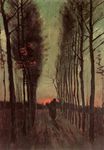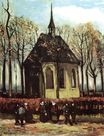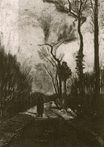Винсент Ван Гог - Прихожане покидающие реформатскую церковь в Нюэнене 1884
 |
 |
 |
 |
 |
 |
 |

Прихожане покидающие реформатскую церковь в Нюэнене 1884
41x32см холст/масло
Amsterdam, Van Gogh Museum
<< Previous G a l l e r y Next >>
From Wikipedia, the free encyclopedia:
Congregation Leaving the Reformed Church at Nuenen (Dutch: Het uitgaan van de hervormde kerk te Nuenen) is an early painting by Vincent van Gogh, made in early 1884 and modified in late 1885.
The work was painted in Nuenen, a small village in the North Brabant district of the Netherlands, a few miles northeast of Eindhoven. Van Gogh's father became the pastor of the Dutch Reformed Church in Nuenen in 1882, and Van Gogh lived with his parents at the vicarage in Nuenen from December 1883 to May 1885. During this time, he made a number of paintings of the local peasants, including The Potato Eaters, and also paintings of the church.
The oil on canvas painting measures 41.5 by 32 centimetres (16.3 in × 12.6 in). It was made in January or February 1884, showing Van Gogh's father's small church, with hedge and bare trees. Van Gogh made the painting for his mother, while she was confined to her house with a broken leg. It was based on an earlier sketch; like the sketch, the painting originally included a peasant with a spade in the foreground, but it later painted out - probably in late 1885 - when Van Gogh also added the congregation, and leaves to bare trees. The congregation are in mourning clothes: Van Gogh's father had died in March 1885
It held by the Van Gogh Museum in Amsterdam but it was stolen on 7 December 2002, along with Van Gogh's early painting of Beach at Scheveningen in Stormy Weather. It remained missing for over 13 years, until it was recovered by the Italian Guardia di Finanza at Castellammare di Stabia near Naples in January 2016, without its original frame. Its recovery was not announced until September 2016, and it was subsequently returned to the museum and went back on display in March 2017.